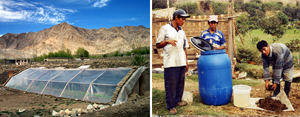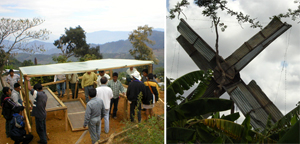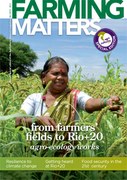The access to and depletion of energy sources is an issue that is receiving more and more attention, especially in relation to agriculture and rural areas. Key aspects in this debate include how to use existing energy sources sustainably and how to develop more sustainable sources of energy. This leads to the questions of how agriculture can become more energy‑efficient, and the potential (and risk) of alternative energy sources, such as bio‑fuels.

At times, energy has been overlooked in the development debate, but recently it has again been receiving greater attention. Some people talk about “energy poverty” and point out that better access to energy by “energy-starved” people can significantly contribute to achieving the Millennium Development Goals (MDGs).
Energy access can reduce extreme poverty (MDG 1) by enabling new income-generating activities, and reduce time spent on collecting firewood. Electricity makes it possible to study more (MDG2), watch TV and use mobile phones.
Studies have shown that girls, in particular, take advantage of the extra study hours (MDG 3). Access to energy can reduce child mortality, improve maternal health, and help combat HIV/AIDS and other diseases (by, for example, providing clean water). Replacing firewood with biogas or electricity reduces respiratory diseases (MDGs 4, 5 and 6). And, better access to energy can improve environmental sustainability by reducing deforestation (MDG 7).

The link between energy and climate change is now widely recognised, but increased access to energy does not have to result in climate change. For a start, energy use does not have to be as wasteful as it has often been in industrial agriculture. Instead of treating energy as a consumable item, purchased from outside, we need to think in terms of energy flows, as we do with nutrients and water in agriculture. How can we reduce energy waste? How can we increase energy efficiency? How can we re-use energy?
While conventional agricultural production systems rely heavily on fossil fuels, both for machinery and for the production of fertilizers, the majority of small-scale farms use a minimum of fossil-based inputs. The benefits of such an approach are many and include a minimal environmental impact, less money spent and increased resilience to fluctuations in fossil fuel prices.
Aiming at universal access?
The burning of wood, dung and crop residues accounts for one third of the energy used in developing countries. Households, however, find it increasingly difficult to find wood or dung, so it is important to focus on other energy sources. Some alternative energy solutions such as biogas, micro-hydro dams and wind power have matured and are spreading fast. Modern solutions like photovoltaic (PV) solar panels have dropped significantly in price over the last few years and are becoming competitive with other sources of energy.
However, many of these technologies require heavy investments upfront. Many poor people who could benefit from these alternative forms of energy are not in a position, for example, to adopt PV solar panels – which can easily cost up to US$ 500 for one household. Even with less costly options, like the micro-hydropower systems seen in Nepal, the upfront costs are too high for communities to shoulder by themselves.
At the same time, many countries have laws in place to protect national electricity suppliers by outlawing private micro-grids. At present the current level of investment in “soft” energy provision is only one-fifth of that required to provide access to electricity for all by 2030. The International Energy Agency (IEA) forecast that by 2030 there will still be 1.2 billion people without access to electricity unless policies change significantly.
Many people are afraid of what universal access to electricity would mean in terms of global warming. However, the provision of universal access to electricity by 2030 would only increase global demand for fossil fuels by 0.8% and increase CO2 emissions by 0.7%. This is due to a combination of the low energy requirements among people who are currently off-grid and the expectations that many will be served by electricity generated from alternative energy sources.
Looking for alternatives
The majority of the poorer regions of the world are net importers of fossil fuel. At the same time they have abundant resources of untapped alternative energy. A lack of skills and capital, subsidies on fossil fuels and a lack of supportive policies have prevented significant development of alternative energy technologies in many countries. The major exceptions are Brazil, China and India.
After decades of dedicated government support for research and development Brazil is one of the global leaders in bio-fuel production. The latter two countries are both leaders in decentralised renewable energy provision from wind, small hydro units, biogas, and solar water heating. Most other governments have taken little initiative in developing sources of alternative energy.
Biodiesel and plant oils can act as substitutes for diesel and ethanol as a substitute for gasoline. They can power existing vehicles. This is unlike other alternative fuels, such as electricity or hydrogen, which involve replacing existing vehicles with new ones. Even in rich countries, the adaptations required are prohibitively expensive. When fossil fuel prices went through the roof it seemed very attractive to get farmers to produce bio-fuels which would only require upstream investment to relatively simple processing facilities. It was a dream of a quick and easy switch to a fossil fuel free future, but was not rooted in reality.
The latest bio-fuel hype started around 2005 and saw many governments, together with NGOs and private investors, jump into large projects without doing the necessary homework. In particular, the production of Jatropha curcas was promoted in places where it cannot grow well and farmers were encouraged to produce in places where no markets existed. Information about the right agronomic practices was rarely provided, and nobody paid attention to the importance of creating valuable by-products from the press cake. Unsurprisingly, the yields have been poor and the resulting backlash has been just as large as the hype a few years ago. Today the bio-fuel sector is facing a tough time, both economically and politically.
Examples from different countries show that, as with all sources of energy, it is important to look at the social and economic consequences of every option, the environmental impacts of energy use, and take into account the entire process of distribution. Large-scale hydroelectricity plants, or the large scale production of bio-fuels, may have enormous social, economic and political costs such as displacing people living in an area. The “sustainability” of bio-fuels depends on the energy that is required to produce biofuel crops (for example, whether agrochemicals are used) and on what type of land the crops are grown: if it replaces carbon-rich land, such as natural forests, or other (food) crops, questions need to be asked about the net benefits.
Small-scale solutions
Fossil fuels have played a large role in agriculture, powering generators, pumps and vehicles, the production of artificial fertilizers and allowing supply chains to grow progressively longer. However, several alternative energy sources have emerged which are technically and economically viable and are currently being adopted at a large scale. Each technology has its advantages and disadvantages.
For instance, wind power is cheap but intermittent, i.e. it only works when the wind blows. Small hydroelectric power stations can produce energy on demand but are too expensive for most communities. Bio-gas produces slurry that is a good fertilizer but is difficult to handle and transport. Photovoltaics are durable but can only power light loads. Bio-fuels can directly substitute fossil fuel, but can compete with other crops for labour and land. Solar water-heaters are relatively cheap but prone to clogging if dirty water is used.
Despite the great benefits offered by alternative energy sources, a focus on increasing access to energy can overlook the importance of the techniques and equipment used by many family farmers – and the real energy demand of agriculture. All over the world, farmers are experimenting with the many low-tech energy saving and energy providing technologies that are already available.
Many examples have been documented in this magazine over the years. The kind of energy source used depends largely on availability and price, but also on tradition and personal preferences. Most importantly we should look not so much at the demand for energy, but more at the efficiency of its use. These examples show that small-scale farmers can not only achieve high yields: they are also more efficient than intensive farmers in terms of their energy use.
Text: Flemming Nielsen
Based in the Netherlands, Flemming Nielsen works as an independent researcher at Banana Hill. E-mail: fnielsen@ bananahill.net
References
OECD/IEA, 2011. Energy for all: Financing access for the poor. UNDP, 2009. Expanding energy access in developing countries: The role of mechanical power.
UNDP, 2011. Decentralized energy access and the Millennium Development Goals: An analysis of the development benefits of micro-hydropower in rural Nepal
The Worldwatch Institute 2005: Energy for Development: The potential role of renewable energy in meeting the Millennium Development Goals.

